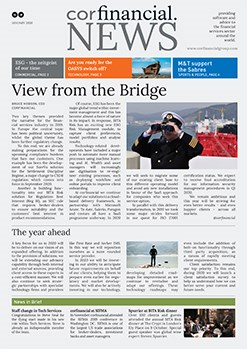When every failed trade will have a price tag
The avoidance of failed trades is now business critical, not a nice-to-have, writes Paul Bowen, corfinancial.
Every failed trade will have a price tag from February 2021.
Although the Central Securities Depositories Regulation (the “CSDR”) came into effect on 17 September 2014, its operational impacts on buy and sell-side firms is just coming into focus. In particular it is the Settlement Discipline Regime (SDR) element of CSDR that will have the most significant impact on market participants.
The SDR reform stipulates that trading venues and investment firms must implement measures to prevent and address failures in the settlement process. Every failed trade will cost businesses. Where a settlement fail does occur, CSDs must impose cash penalties on failing participants. The basis of the penalty is determined by the number of business days beyond settlement date that a transaction remains unsettled. Over and above this, there will also be a mandatory buy-in process for failed trades and the recovery of the costs will be passed on to the defaulting party.
In other words, increased settlement discipline and the avoidance of failed trades is now business critical, not a nice-to-have.
Slipped through the net
One may ponder, when so much automation has been successfully introduced into middle and back office processes over the years, how it is that failed trades have slipped through the net? How have failed trades become the last bastion of non-automation?
It could be argued that current penalties are not significantly punitive or material to attract focus and investment in this process. With the introduction of the new penalty structure, however, non-compliance could result in significant monetary and reputational cost. In a sense, therefore, failed trades were not the highest priority; SDR will have a substantial impact as it formalises the settlement process and gives failures added significance.
Another factor is SWIFT messaging. This communication method has been available for many years yet has not been adopted in its entirety. The custodians instead have often provided failed trade reports, either through portals or daily spreadsheets. The problem here is that all those portals and spreadsheets are different, with the result that the buy- and sell-sides would assign multiple resources to manually process numerous failed trade reports and rationalise them as best they could. The custodians had little incentive to introduce standardisation, hence manual workarounds were commonplace.
Operational challenges
In operational terms, there are several obstacles that the industry must overcome in order to effectively deal with SDR.
Firstly, the industry must minimise the cost impact of buy-ins. Trade failures will often occur in illiquid markets where there is a shortage of stock. If a firm is receiving buy-ins in illiquid markets, potentially there could be some large price differentials at a ‘Buy-in-Auction’ at the end of the day. In these circumstances, the premiums levied by empowered sellers are generally significant, leaving the counterparty at fault and with a painful variance.
Secondly, firms must reduce the manual processing stemming from SDR. This labour-intensive administration is likely to include extensive effort associated with buy-ins. It’s not just a case of sending an email; asset managers, for instance, may need to start cancelling trades, rebooking trades, pursuing the brokers for all the fines and so on. The introduction of SDR will mean that businesses will have to deal with far more manual workarounds.
Thirdly, operational teams must prove that they are in control of the settlement process. These teams will now need to report in more detail to senior management on unsettled trades and counterparty exposure. One of the key observations from the Lehman collapse was the lack of information regarding consolidated counterparty exposures. The new SDR regime, while imposing penalties, has the benefit of reducing settlement exposure and cash management for all parties involved in the trade cycle.
In summary, the most significant changes being made through SDR is fining firms, introducing rigour around buy-ins and reporting the worst offenders. All firms need to proactively prevent trade failures, understand their exposure to unsettled trades and protect their company’s reputation. SDR means asset managers and brokers must move nearer to real-time monitoring, compelling them to transition up the settlement cycle and adopt a pre-settlement mentality.
Just looking at trade fails is not solving the problem.
Paul Bowen
Senior Executive – Operations corfinancial
info@corfinancialgroup.com
Post trade transparency: shining a light into dark corners
An effective post-trade programme is now business critical, writes David Veal, Senior Executive - Client Solutions at corfinancial.
Although well over ten years ago, many people still vividly remember the immediate chaos during the financial crisis. Firms were scrambling to understand counterparty exposures and settlement risk, along with a key requirement to know the exact state of asset and cash positions. Executed transactions sitting between trade date and settlement date fell into deep voids where the status, even post-settlement date, was not absolutely clear. It took many firms days, sometimes even weeks, to piece together a conclusive picture of the actual situation.
With multiple industry utilities, a plethora of systems and with transactions recorded in multiple mediums (including paper tickets ‘enhanced’ with coloured marker pens, faxes and spreadsheets) it swiftly became clear that such an environment only works when the outside world cooperates. Post-crisis, sanctions were introduced to impose responsibilities and liabilities upon firms, with the aim of firms having more control of transaction data. Equally, lucidity in post-trade processes supports the maintenance of IBOR platforms that also require near real-time position data. Can a company therefore survive without a transparent post-trade system? The regulators would say ‘absolutely not’.

The upcoming enhancements to the Central Securities Depositories Regulation (CSDR), which must be implemented by February 2021, pushes the responsibilities even further. In particular, the Settlement Discipline Regime (SDR) within CSDR means that where a settlement fail does occur, CSDs must impose cash penalties on failing participants, as well as compulsory buy-ins after a short time. The impact of this change will only add to reputational damage for parties that are unable to apply effective measures and controls.
I would argue that a better level of post-trade transparency brings challenges but also opportunities for the industry as a whole. Depending on the definition of transparency, additional controls and processes improve the ability to monitor the settlement status of a transaction and reduce exposure to settlement risk.
It’s time to shine a light into the dark corners.
Welcome to corfinancial NEWS – January 2020
In this issue you will be able to read about our business plans for this year and exciting new product developments. These developments include a ground-breaking solution to the Settlement Discipline Regime as well as enhancements to BITA Risk (associated with key industry issues such as ESG).
Click the NEWS to read now.






